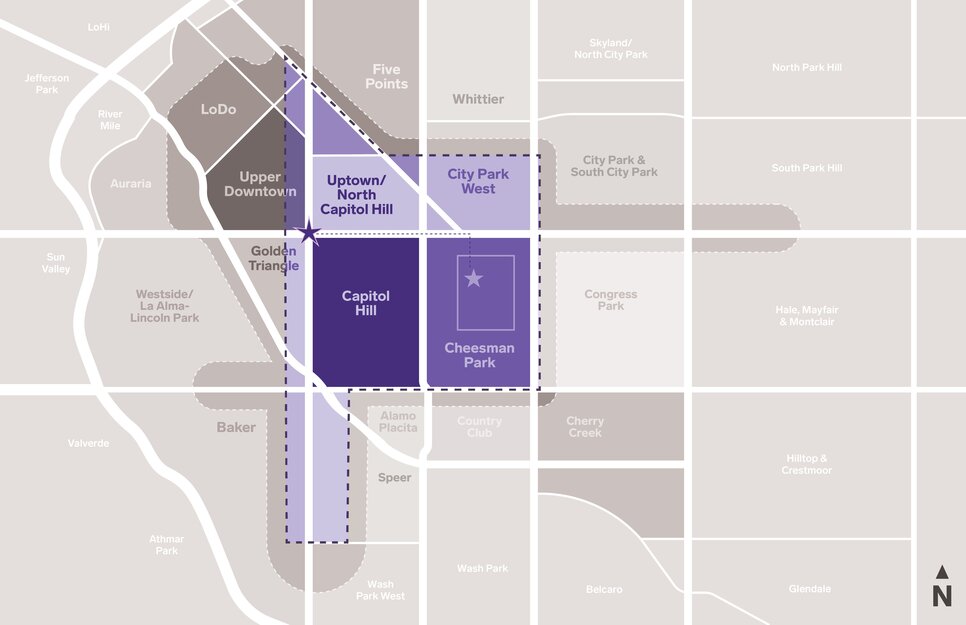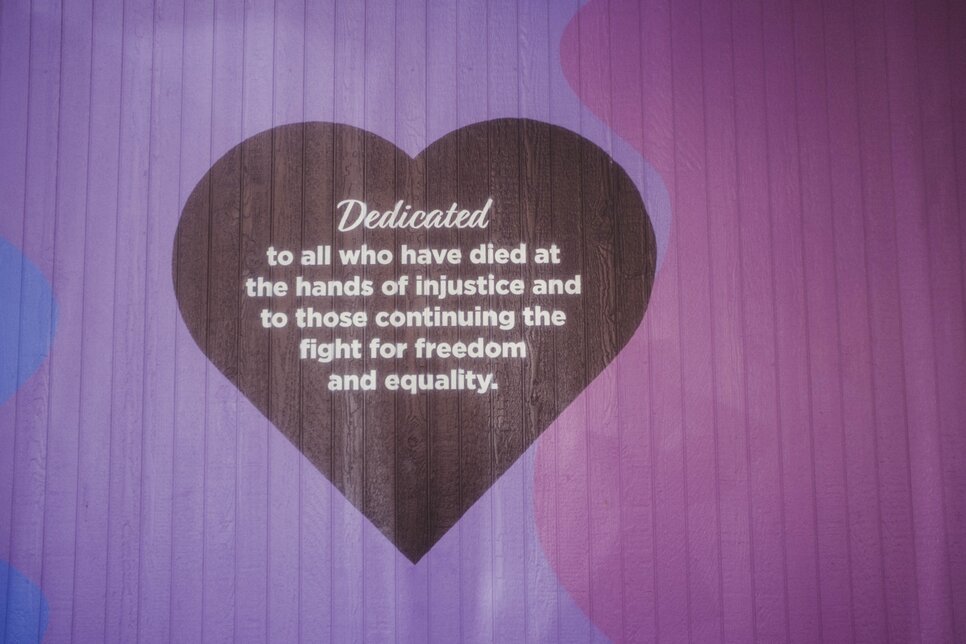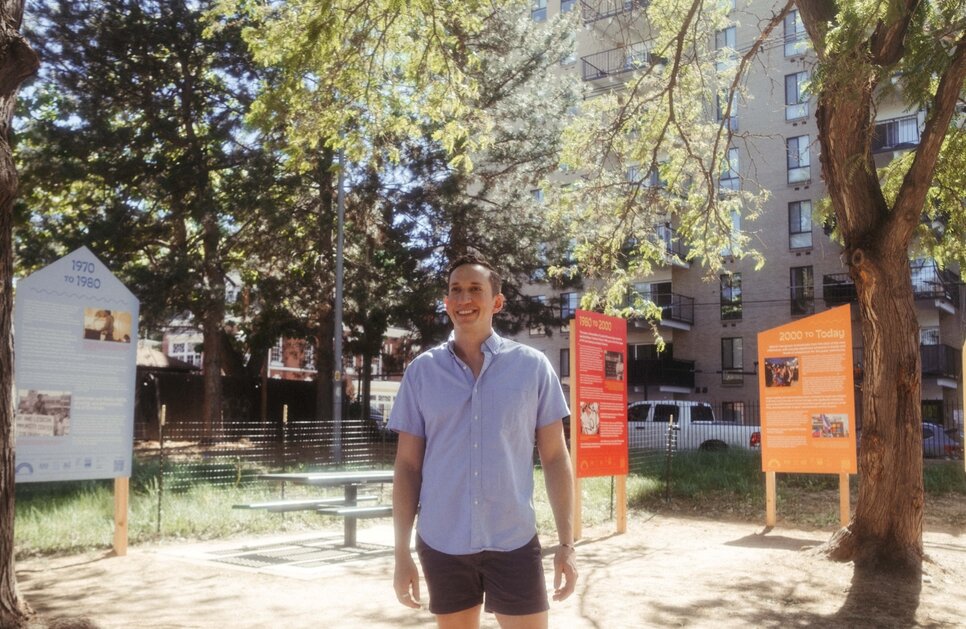Denver groups make headway on creating the city’s first Queer Cultural District
share

DENVER — A wide grin spread across Zach Kotel’s face as he pointed out flags hung across East Colfax between the state Capitol and Franklin Street.
The flags — some rainbow, some purple, some multicolored and displaying faces of prominent LGBTQ+ Coloradans — decorate what Kotel hopes to rename and delegate “Lavender Hill,” Denver’s first Queer Cultural District.
“Essentially, we’re formalizing what has, historically, been Denver’s ‘Gayborhood’ and promoting a sense of LGBTQ+ culture in the present-day as well,” said Kotel, co-founder and executive director of the Lavender Hill Cultural District. “The idea is that bringing visibility out into the world will help with the eventual creation of a concrete district.”
Kotel has worked with Black Pride Colorado, The Center on Colfax and The Colfax Avenue Business Improvement District to draw up plans for a “gayborhood,” akin to famous, historic queer neighborhoods like the Castro in San Francisco or Northalstead in Chicago.

The groups envision the area — which includes the Capitol Hill, South Broadway, Cheesman Park, City Park West and Uptown neighborhoods — as a space for public art, historic markers and queer-owned businesses.
Kotel said the name “Lavender Hill,” was a natural choice because of the plant’s association with the community.
In the 1940s through 1960s, gay people could be fired from federal government jobs if their identity was discovered, which historians refer to as the “Lavender Scare.”
Then, in 1969, lavender became a symbol of empowerment after the Stonewall Riots.
“Suddenly, lavender became a thing that was rehabilitating what had once been a negative thing and bringing it forward as a positive thing,” said Rex Fuller, CEO of The Center on Colfax. “I think that's what happens in a lot of queer communities.”
Past to present
Throughout the 1970s and 1980s, most Denver neighborhoods had zoning laws that required cohabitants to be related through marriage or blood. Since gay marriage was illegal, same-sex couples in Denver had limited options for where they could live together.
Capitol Hill — the area between sixth and 15th avenues, stretching from the Capitol to Cheesman Park — was one of limited options, and many same-sex couples flocked to the area.
“It’s now some of the more expensive real estate in town but it wasn't always that way, so it was were queer folks could move in and make themselves comfortable and make a name for themselves,” Fuller said. “It kind of evolved from there and a lot of the political activism was centered there.”
In 2024, as rates of LGBTQ+ acceptance are at historic highs, Fuller said the community can live practically anywhere, so Capitol Hill is not what it once was.
“I know now a lot of queer people who live in the suburbs which just wasn’t possible a generation or two ago,” Fuller said. “The neighborhood has become more diluted and we want to be intentional about creating and preserving that sense of place.”
Phil Nash, an activist and author of “LGBTQ Denver,” said he has seen the city through several eras of an LGBTQ+ renaissance since he and his husband moved to town in 1974. At the time, Denver police officers frequently harassed and arrested anyone suspected of homosexuality. Gay bars were spread throughout Lower Downtown in what was known as Denver’s “Red Light District.”
As queer liberation-focused groups sprouted up around the country in the wake of the Stonewall Riots, Nash and his husband decided to be “out and proud,” while joining the movement.
“The main issue the community faced was just an environment that had developed over the middle part of the 20th century in which homossexuals were considered sick and against the law,” Nash said. “Consequently, you didn’t see very many public gay couples.”

A sign showing support for the LGBTQ+ community on East Colfax Avenue.
Photo: Peter Vo, Rocky Mountain PBS
Photo: Peter Vo, Rocky Mountain PBS
Making Lavender Hill
The groups responsible for creating Lavender Hill included parts of the city with historic significance for the LGBTQ+ community, areas with queer-specific businesses and parts of the Denver Pride Parade route.“Denver has very specific moments in the greater queer rights movement,” Kotel said. “It’s not all San Francisco and New York City.”
Kotel said the groups eventually hope to have Lavender Hill formalized by the city, but want the effort to be community-led, and an official designation is not the community’s first priority.
“There’s no specific precedent in this city for what we’re trying to do,” Kotel said. “This is not just a historic district or an arts district, so it’s a question of creating the right structure to be symbiotic with all of our various partners and neighbors.”
This year, the groups are focused on bringing more public art and historic education into the district.

Zach Kotel, co-founder and executive director of the Lavender Hill Cultural District, stands at the Quality Hill Park.
Photo: Peter Vo, Rocky Mountain PBS
Photo: Peter Vo, Rocky Mountain PBS
Though gay bars in Denver were once centered around Downtown and Broadway, many closed during the COVID-19 pandemic and the rise of the internet, as people no longer needed to visit bars to meet others and could instead connect on apps.
Though many downtown joints closed, others popped up just a few blocks south and east, on South Broadway and East Colfax.
Denver’s stretch of East Colfax between Sherman Street and City Park is home to eight “official,” gay bars. Above Ground Denver, a hair salon catering specifically to LGBTQ+ people, opened its second location in the area, and Needz, an adult store, relocated from South Broadway to Colfax and Emerson. Both shops opened on Colfax within the last two months.
Many restaurants and other businesses in the area that are not queer-specific still boast rainbow flags and offer deals during Denver Pride.
Steven Alix, who owns seven businesses on Colfax (five are official gay spaces), said he “fell in love with Colfax,” after moving to Denver 20 years ago. He bought each of the businesses while they were something else and turned them into landmark Denver gay spots.
“I want a specific, walkable neighborhood where gay people from all over can come to and say ‘hey, I’m home,’” Alix said. “It’s very simple, just make it look gay.”
Colfax — where all of the “Lavender Hill” flags are flying and the city’s LGBTQ+ community center is located — is the longest commercial street in the United States. The street has a reputation for “grittiness,” and the street’s struggles with drug use and homelessness have drawn national attention.
Frank Locantore, executive director of the Colfax Ave Business Improvement District, said Colfax’s grittiness mirrors the grit for the people who frequent it.
“I hope Colfax is always going to be gritty, because the people that inhabit it are the ones that are always going to make things work,” Locantore said. “Not in an elon musk kind of way, but in a Colfax kind of way.”
